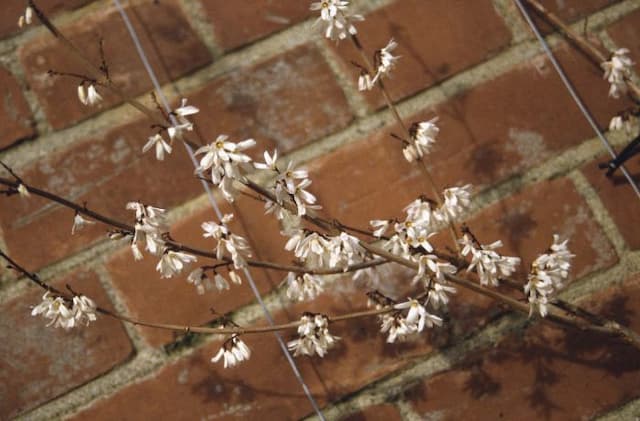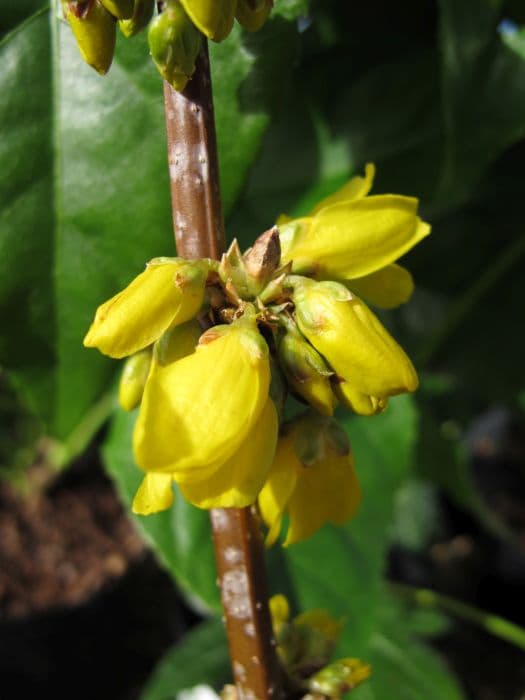Dwarf Korean Lilac Syringa 'Red Pixie'

ABOUT
Syringa 'Red Pixie', commonly known as a type of lilac, is recognized for its aesthetically pleasing appearance due to its vibrant flowers and lush green foliage. Typically, the plant showcases an array of small, tubular flowers which bloom in conical clusters. These blossoms exhibit a color that, despite its name 'Red Pixie', is a deep pink to purple hue, often with a gradient of tones from the outer petals to the center. The leaves of this lilac variety are heart-shaped with a pointed tip, providing a lush backdrop for the bright blooms. They are arranged in opposite pairs along the stems, which gives the plant a dense, leafy look. The leaves have a smooth texture and a rich green color that contrasts nicely with the flowers. As for the overall structure, without mentioning specific dimensions, this plant presents a compact, bushy form. It tends to be more rounded, with a good amount of branching that supports the weight of the flower clusters. The branching pattern adds to the ornamental appeal of the plant, adding depth and volume to its appearance. Meanwhile, the bark and stems of 'Red Pixie' lilac are woody and contribute to the sturdy nature of the plant. The stems may have a slightly weathered look which is typical for woody shrubs, giving it a mature and enduring presence within a garden setting. Finally, when in full bloom, the plant is not simply a visual treat but also emits a sweet and recognizable fragrance which can permeate the surrounding area, adding yet another delightful characteristic to its appearance.
About this plant
 Names
NamesFamily
Oleaceae
Synonyms
Dwarf Korean Lilac, Red Pixie Lilac
Common names
Syringa 'Red Pixie'.
 Toxicity
ToxicityTo humans
Lilacs, including the cultivar 'Red Pixie', are considered to have a low level of toxicity to humans. However, ingestion of large quantities of leaves or stems may cause gastrointestinal upset, including symptoms such as abdominal pain, vomiting, and diarrhea.
To pets
Lilacs, including the 'Red Pixie' variety, are generally not toxic to pets such as dogs and cats. While they are not known to cause serious harm if ingested, it is still possible for pets to experience mild gastrointestinal upset, such as vomiting or diarrhea, if they consume large amounts of the plant.
 Characteristics
CharacteristicsLife cycle
Perennials
Foliage type
Deciduous
Color of leaves
Green
Flower color
Pink
Height
4-5 feet (1.2-1.5 meters)
Spread
4-5 feet (1.2-1.5 meters)
Plant type
Shrub
Hardiness zones
3-7
Native area
Asia
Benefits
 General Benefits
General Benefits- Compact size: 'Red Pixie' is a smaller cultivar of lilac, making it suitable for gardens with limited space or for container planting.
- Attractive foliage: It has dark green foliage that provides a beautiful backdrop for the flowers as well as visual interest when the plant is not in bloom.
- Vibrant blooms: The plant produces deep red-purple flowers that add a unique and vibrant pop of color to the landscape.
- Fragrant flowers: Lilacs are known for their highly fragrant flowers, which can add a delightful scent to the garden.
- Pollinator-friendly: The flowers attract bees, butterflies, and other pollinating insects, supporting local ecosystems.
- Low maintenance: Once established, lilacs are relatively low-maintenance, requiring minimal care beyond occasional pruning.
- Drought tolerance: With adequate acclimation, these plants can withstand periods of drought, reducing the need for frequent watering.
- Cold hardiness: Lilacs are cold hardy and can survive in cooler climates, making them a robust choice for northern gardeners.
- Decorative use: The flowers of the lilac are commonly used in bouquets and arrangements, making them popular for cut flower enthusiasts.
 Medical Properties
Medical PropertiesThis plant is not used for medical purposes.
 Air-purifying Qualities
Air-purifying QualitiesThis plant is not specifically known for air purifying qualities.
 Other Uses
Other Uses- Culinary Decoration: The blossoms of the Lilac 'Red Pixie' can be used to add a beautiful pop of color to salads or as edible garnishes on desserts, provided they are free from pesticides and chemicals.
- Artistic Inspiration: Artists may use the vibrant red-purple hues of the 'Red Pixie' Lilac for color palette inspiration or as a subject for floral paintings and photography.
- Homemade Potpourri: Dried 'Red Pixie' Lilac flowers can be combined with other dried botanicals to create a fragrant potpourri blend for freshening indoor spaces.
- Natural Dye: The flowers of the 'Red Pixie' Lilac may be used to create natural dyes for fabrics, yarns, and paper, giving them a delicate lavender tint.
- Wedding Decor: Due to its appealing aesthetic and fragrance, 'Red Pixie' Lilac can be utilized in wedding bouquets, centerpieces, or as part of venue decorations.
- Crafting: The sturdy stems and attractive blooms of the 'Red Pixie' Lilac can be incorporated into homemade wreaths, garlands, or other craft projects.
- Candle Making: Lilac 'Red Pixie' flowers can be embedded into candles to add visual appeal and a subtle fragrance when used with appropriate waxes and wicks.
- Fragrance Sachets: Dried 'Red Pixie' Lilac petals can fill small sachets to delicately scent drawers, closets, and small rooms.
- Eco-Friendly Confetti: Fresh or dried petals of the 'Red Pixie' Lilac can serve as biodegradable confetti for celebrations and outdoor events.
- Garden Design: 'Red Pixie' Lilac can be used in garden design to create a sense of depth and contrast when planted among plants with lighter-colored flowers or foliage.
Interesting Facts
 Feng Shui
Feng ShuiThe plant Lilac is not used in Feng Shui practice.
 Zodiac Sign Compitability
Zodiac Sign CompitabilityThe plant Lilac is not used in astrology practice.
 Plant Symbolism
Plant Symbolism- Love: The Syringa, commonly known as lilac, is often associated with love and affection, perhaps due to its sweet fragrance and heartwarming blooms.
- Innocence: Lilacs symbolize youthful innocence and the joy of early love, embodying the purity of first emotions.
- Renewal: The blooming of lilac bushes in the spring represents renewal and the freshness of a new season, reminding us of new beginnings and fresh starts.
- Nostalgia: With their strong and pleasant scent, lilacs can evoke nostalgic memories of past springs and are often symbolically connected to the past.
 Water
WaterDwarf Korean Lilac, or Syringa 'Red Pixie', should be watered deeply to ensure moisture reaches the root zone; it's best to water this plant when the top inch of soil feels dry to the touch. This typically requires watering once a week, but frequency can vary based on weather conditions and soil type. Provide the plant with about 1 gallon of water per watering session during the growing season, ensuring an even distribution around the root area. During the dormant season in winter, watering can be reduced significantly. Always avoid overwatering to prevent root rot.
 Light
LightDwarf Korean Lilac prefers full sun conditions, with at least 6 hours of direct sunlight to thrive and produce the best blooms. It can tolerate partial shade, but flowering may be less prolific. Plant this lilac in a spot that gets plenty of morning light and some afternoon shade in hotter climates to protect it from intense heat.
 Temperature
TemperatureDwarf Korean Lilac requires a temperate climate, with ideal growing temperatures ranging between 60 to 75 degrees Fahrenheit. It is hardy and can tolerate winter cold down to about -30 degrees Fahrenheit without significant damage. In the spring and fall, Dwarf Korean Lilacs appreciate cooler temperatures as they can enhance the flowering process.
 Pruning
PruningDwarf Korean Lilacs benefit from pruning immediately after flowering to shape the plant and encourage new growth for the following season. Pruning not only helps maintain a compact, attractive shape but also removes spent flowers, which can increase blooming for the next year. It's best to prune these lilacs annually, focusing on the removal of any dead or broken branches and thinning out crowded areas to improve air circulation.
 Cleaning
CleaningAs needed
 Soil
SoilThe best soil mix for a Dwarf Korean Lilac (Syringa 'Red Pixie') should be well-draining, loamy, and fertile with a pH ranging from 6.0 to 7.5. A mix of two parts loam to one part peat moss and one part perlite or coarse sand is ideal to ensure proper drainage and aeration.
 Repotting
RepottingDwarf Korean Lilac typically does not need to be repotted frequently, as it is a slowly growing shrub. It should be repotted or transplanted only when it has outgrown its current space, usually every few years.
 Humidity & Misting
Humidity & MistingDwarf Korean Lilac prefers average humidity levels. It is quite adaptable but thrives best in environments with humidity levels that mimic its natural habitat, without the need for specific humidity control.
 Suitable locations
Suitable locationsIndoor
Place Dwarf Korean Lilac near a sunny window; water regularly.
Outdoor
Plant in well-draining soil, full sun, and water deeply.
Hardiness zone
3-7 USDA
 Life cycle
Life cycleThe Dwarf Korean Lilac 'Red Pixie' begins its life cycle when a seed germinates, typically in the spring following a period of stratification to break dormancy. It then grows into a young sapling, establishing a root system and developing its first leaves. As the plant matures, it enters a vegetative state, where it focuses on leaf and stem growth, becoming a small shrub. Once mature enough, usually after a few years, it enters the flowering stage, producing fragrant reddish-pink blooms in late spring to early summer, attracting pollinators. After pollination, the flowers develop into brown capsules containing seeds, which are dispersed by wind or animals, completing the reproductive cycle. The Dwarf Korean Lilac 'Red Pixie' can live for many years, going through cycles of dormancy in the winter and regrowth in the spring.
 Propogation
PropogationPropogation time
Spring-Early Summer
The Syringa 'Red Pixie', commonly known as the Dwarf Red Lilac, is best propagated through softwood cuttings. The optimal time for taking cuttings is in late spring to early summer when new growth is still flexible but has started to mature. To propagate, cut a 4 to 6-inch length (approximately 10 to 15 centimeters) from a healthy branch, making sure it has at least two leaf nodes. Dip the base of the cutting in rooting hormone powder before planting it in a well-draining potting mix. The cutting should be placed in indirect light and kept consistently moist until roots develop, which typically occurs within 4 to 8 weeks. Once rooted, the new Dwarf Red Lilac can be transplanted to a more permanent location outdoors.









